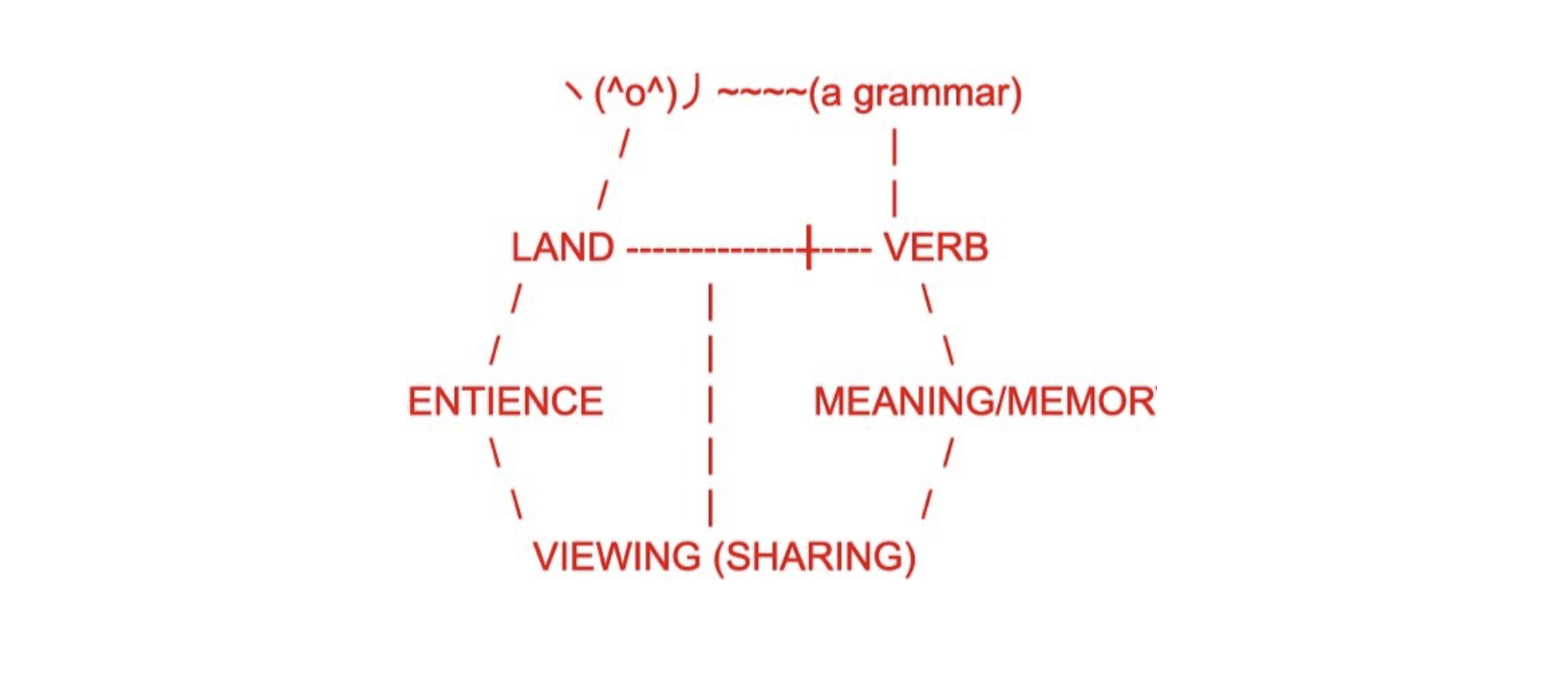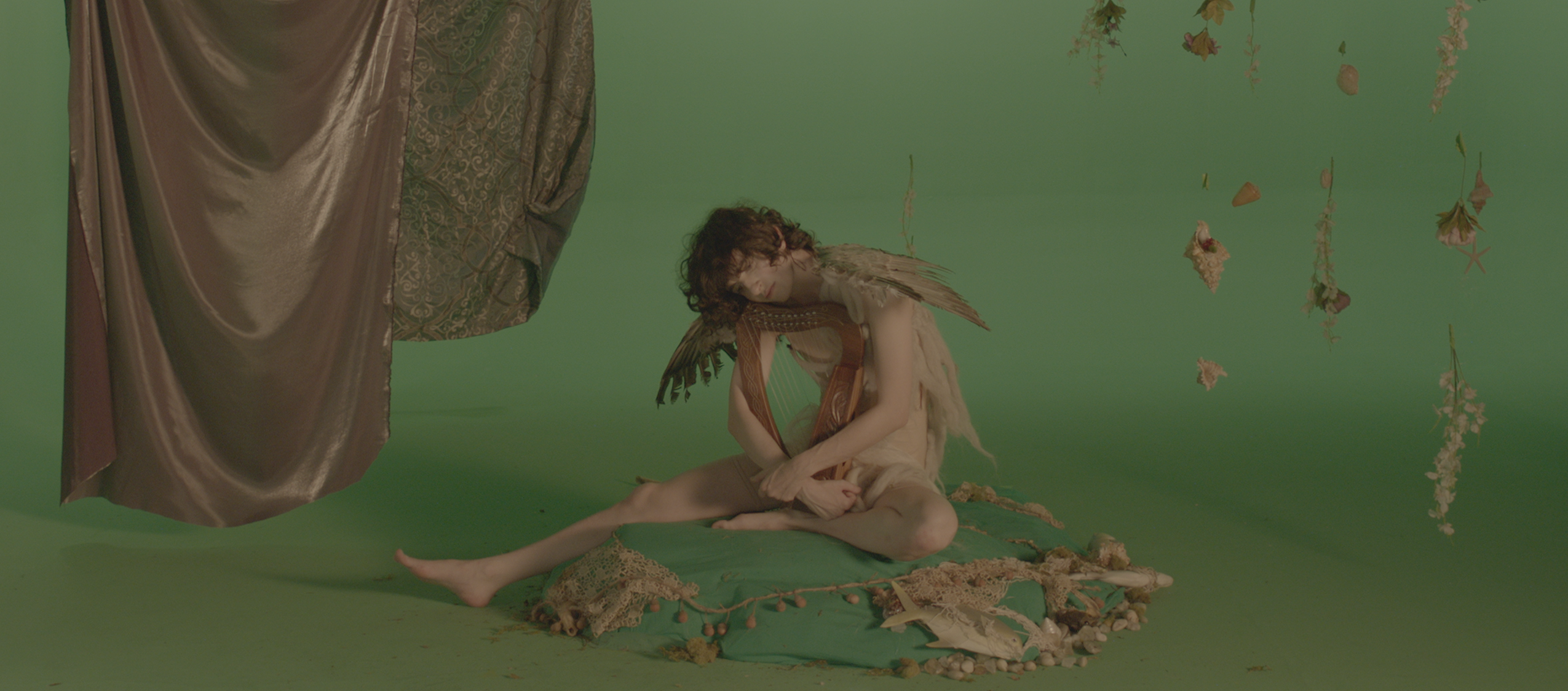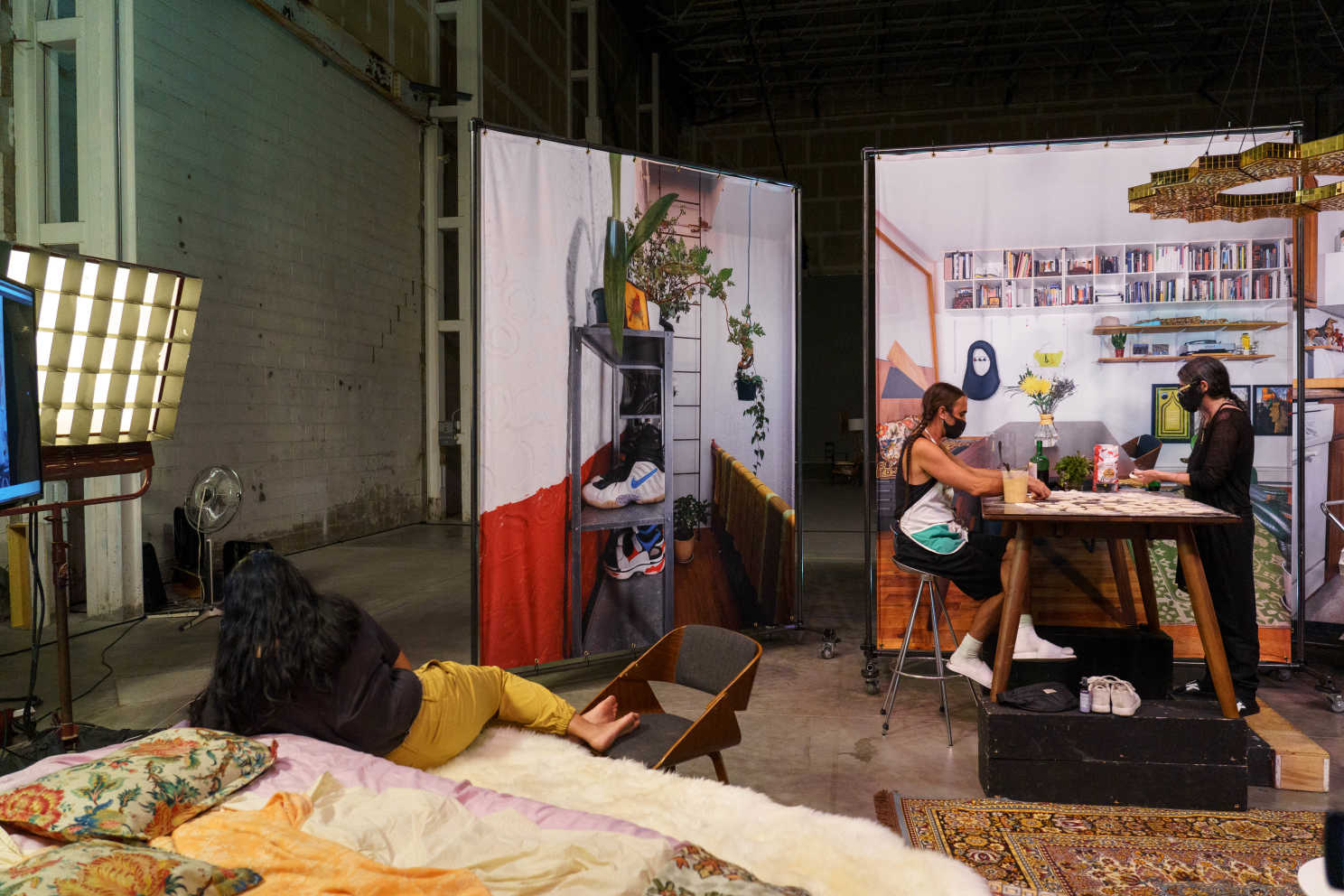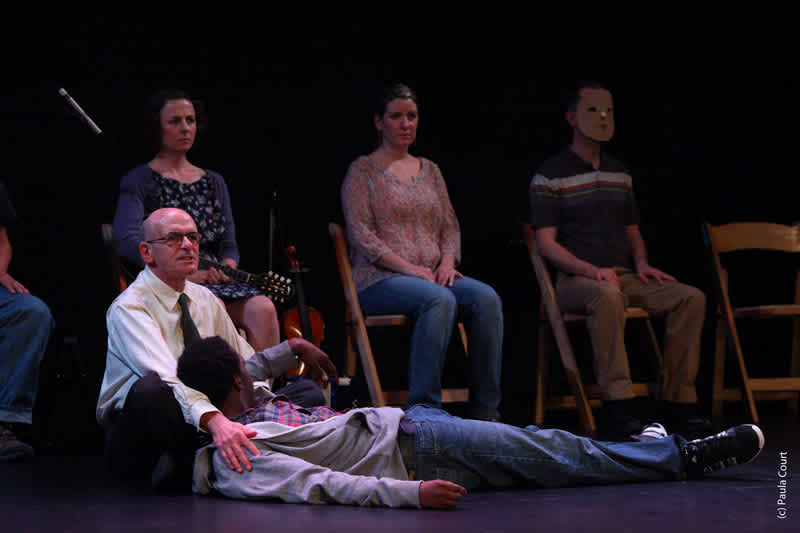
Credits:
By Elizabeth Wiet, 2019–2020 Curatorial Fellow
January 17, 2020
Richard Maxwell is a playwright and theater director best known for his work with the New York City Players, a company he founded in 1999. Utilizing sparse sets and often laconic acting styles, Maxwell reduces theater to its most essential elements, creating plays that, in the words of critic Hilton Als, oscillate between the “mythic” and the “mundane.” A longtime friend of The Kitchen, Maxwell first presented work here in 1996 with the play Clowns Plus Wrestlers. His newest play, Queens Row, was commissioned by London’s Institute of Contemporary Arts in 2018. It opened at The Kitchen on January 8 and runs through January 25.
In advance of Queens Row’s opening, Maxwell sat down with The Kitchen’s Curatorial Fellow, Elizabeth Wiet, to talk about minimalism, making theater in unconventional spaces, the influence of his Midwestern childhood on his work, and how he came to develop Queens Row.
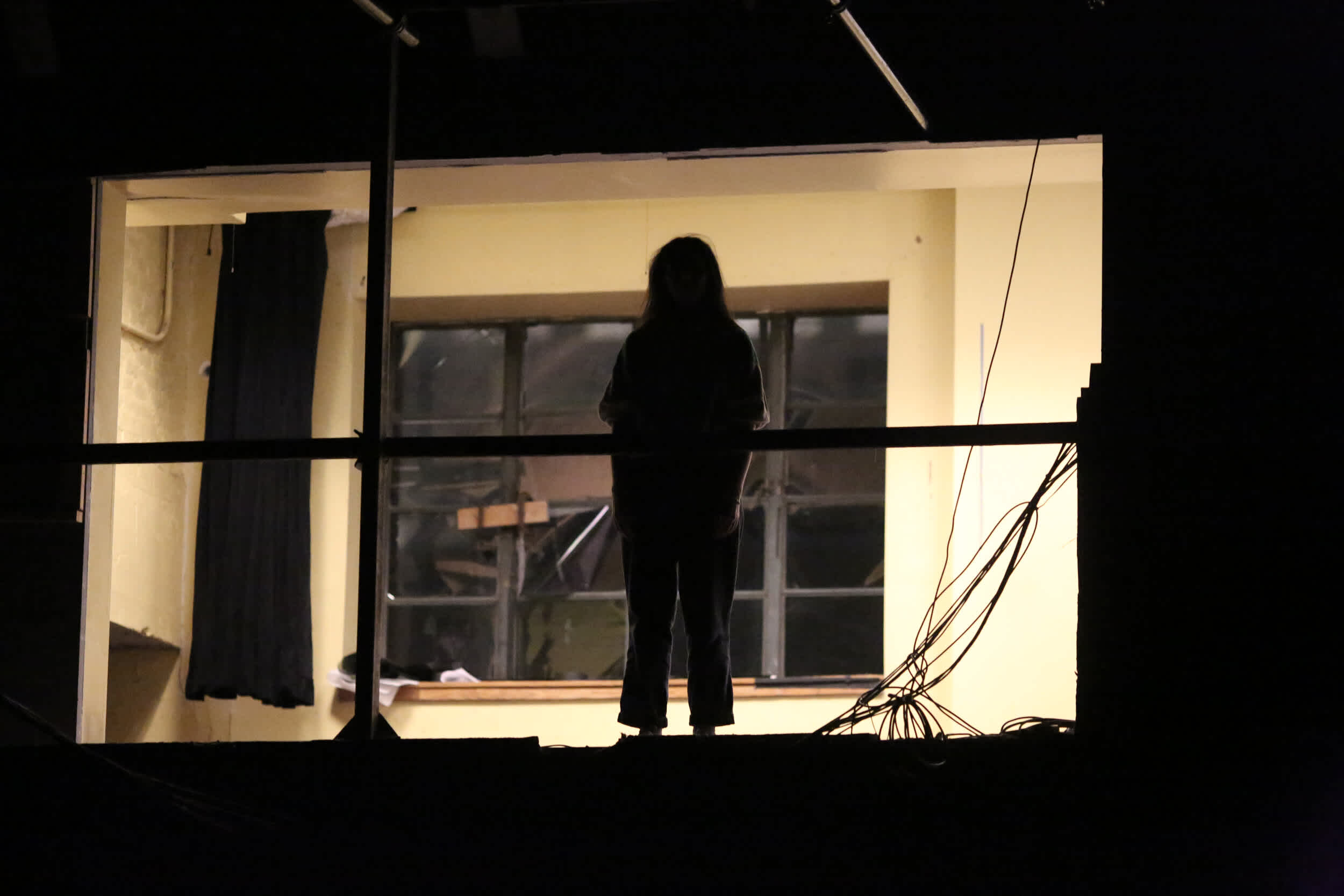
You come from a very formal theater background: you trained in the acting program at Illinois State University; you began your career at the Steppenwolf Theatre in Chicago; and your sister was a Broadway actress. But at the same time, your work has largely been presented in spaces that are interdisciplinary or cross-disciplinary: places like The Kitchen, the Walker Art Center, the Whitney Biennial, and the Chinati Foundation in Marfa, Texas. You’re also newly represented by Greene Naftali, and your play Paradiso opened at the gallery last year. What does it mean for you to present theater work in these kinds of spaces?
One thing that really excites me is locations. Having spent so many years making work inside of black box theater spaces, at a certain point, I started to yearn to get outside of that framework. My pursuit of alternative spaces began with a play I wrote in 2003 called Showcase. There’s this APAP conference (the Association of Performing Arts Presenters) that happens every January. The conference takes place at a hotel and you can get a booth on the exhibition floor to showcase whatever your company and your work is about. I always thought it would be nice to actually make a show that happened in the booth, rather than just representing work on video. But the booths happen to be really expensive. So, we got a hotel room and created a show about a businessman attending a conference. You can’t see his face, and he’s naked. He talks to his shadow, which is a guy dressed all in black, head to toe. I only had about two or three weeks to write and rehearse this, so the space really determined a lot of the writing. And that’s how I embarked on this exploration of how rooms can influence the creative process.
And just to bookend that with what we’re doing here, with Queens Row: this show, which premiered at the Institute of Contemporary Arts in London, was borne out of the ICA’s renovations. I was really happy that we could further that along by taking out the floor sooner than they had planned. We really took apart the space. Now, we can do that at The Kitchen as well. This gallery on the second floor is not being used for exhibitions at this moment in The Kitchen’s season, so we have been able to make physical changes to the space. That’s where I want to be: in a gallery that is in transition. Given what my career trajectory has been, and is, it feels like that’s a really appropriate place to be.
Right. The space is itself a bit liminal right now.
Yeah, that’s a good way to put it.
I want to circle back to Marfa: The Chinati Foundation was founded by Donald Judd, a sculptor famously associated with minimalism—though critics and Judd himself have certainly pushed back against the inadequacy of that term to describe his practice. Your theater work, with its relatively bare stages and often affect-less acting, has also been described as minimalist. Is minimalism a term through which you understand your theater?
Not really, though I think about it a lot. What I think right now is that minimalism in theater is just not possible. You can reduce, you can make things spare, but when you’re working with people—with live bodies—I don’t see how you can call that minimal, or minimalist. And that’s one thing I’ve discovered along the way.
But I will say this about Donald Judd. One of the most compelling descriptions I’ve found about how one encounters Judd’s minimalist sculpture is actually very theatrical. One thing he has said about his own work is that you can make a cube, and then present that, and as viewers look at it, they’re asking questions: “what does this symbolize,” “what is the meaning behind this cube?” Whereas Judd would simply say, “it’s a cube.” That’s all you’re going to get. That’s it. So, as a viewer, you have to decide for yourself what it means. And that to me is how theater should operate.

Related to our discussion of minimalism: Another term that often pops up in writing about your work, particularly about acting style, is “guilelessness.” It’s a term that, to me, as someone who grew up in a small farming town in Illinois, seems to resonate with certain cultural ideas we have of the Midwest. There is this idea that the Midwest itself is guileless and unaffected. That it is a place of earnest, hardworking, everyday people—a place in the “middle,” a place that eschews extremes. That idea of eschewing extremes, of plainspokenness, resonates with certain critical appraisals of your work. You grew up in North Dakota and started your career in Illinois. And your play Neutral Hero, which was presented at The Kitchen in 2012, is set in Perham, Minnesota. Whether as a literal space or as a style: how has the Midwest influenced your work?
It’s totally influenced the kind of things, and people, I want to write about, and write for. Sometimes I’ll give an artist talk, and the first image I’ll show is Interstate 94, which goes straight across North Dakota. One of my earliest memories is being on that road. It’s flat, and you can see forever to the horizon. It’s the opposite of New York in a lot of ways, because in New York, we have this vertical relationship to space. But in the Midwest, its horizontal. The Midwest is a little unsettling for people, because it’s just so wide-open.
That reminds me of a review I read once of Laurie Anderson’s United States I-IV (1983). Obviously, she’s thought of as being very New York, but she grew up in Illinois. And one reviewer commented that the shifted vowels of Anderson’s speech, when she’s not technologically modifying her voice, recalled the flatness of the Midwest. So that idea of flatness, I don’t know if it’s an aesthetic strategy—
I don’t think it’s a strategy per se. I don’t think it’s something willful. When coming to a decision, “should this event or thing take place,” as a director, I always ask, “is it necessary?” Like, if an actor says, “hey what if there was a glass right here—what if I was to pick up that glass and play with it?” My first question would be, “why do you do that?” So I don’t know how strategic that is. It’s just a sensibility. I’m always questioning what’s necessary.
You’re both a playwright and a director. How do you approach those two practices, and for you, what is the relationship between writing and directing?
Historically, I would keep them together. More recently, I’ve tried to separate them out. I now think of them as two things I could do. I don’t need them to be together anymore. I think it helps to separate them, to be willing to write a play for someone else, or direct a play for someone else. That’s where I’m at right now.
How did you begin creating Queens Row, in particular?
I began writing the play when I was down in Texas, and I was impressed with the landscape there. I was writing about life, about what captures folks.
That was when you were in Marfa?
Yes, at the Chinati Foundation. And I was driving a lot—it takes like five days to drive down there, so the concept of America was very much on my mind. With Paradiso, the play I wrote before Queens Row, I had this idea of putting an ad out for casting, but only in Staten Island. I found this guy Charlie from that, who was great. So I thought we could try something similar in London for the ICA commission. In the UK, they have a website called Gumtree. And I was curious to see who might see the ad and be interested. We got about 20 or 25 people for an audition in London. From those people I chose three. One dropped out, but luckily Soraya Nabipour, a PhD researcher who was assisting me at the time, stepped in. These were the three people I ended up writing the play for: Soraya, Nazira Hanna, and Antonia Summer. Based on my travels around, I wanted the play to be about how these women were joined by an absence of a man.
Then, I did a site visit with the ICA. And they showed me the whole place and said, “there’s a theater, but you don't have to use it; we have galleries. What do you want to do?” And after looking at everything, I decided that I would use the theater. It’s the most interesting space to me. Especially knowing that it was going to be renovated. There were possibilities there in terms of changing the look of it.
Queens Row takes place in the aftermath of a fictional American civil war. Two of the actresses, Nazira Hanna and Soraya Nabipour, are of Egyptian and Iranian heritage, respectively. Given the play’s exploration of themes of class, security, and faith, it’s hard not to view the two actresses’ national origins as being significant. Were you thinking about our present political moment while developing the play?
It’s a little tricky to engage in a conversation like that. Because it makes it seem like I chose these women based on their ethnic backgrounds, and I really didn’t. Of course, it’s evident. Antonia Summer is of African descent, from Uganda. Nazira is partially from Egypt; Soraya is partially from Iran. But I was ultimately more interested in hearing three Londoners talk about America. And they happen to be three terrific people whom I enjoyed working with. In that minimalist way, I’d rather let the audience draw their own associations.
There’s still that idea of openness.
Exactly.

As a playwright, you often turn to the form of monologue—where you have a single character speak for an extended period of time. This is true for Queens Row. The play is divided into three parts, with each actress appearing alone on stage to deliver her speech. Why do you return to the monologue, as a form, so often?
It’s efficient. You can say what you’re thinking, and you don’t have to tease it out like you would in dialogue. It gets past the automatic theatricalization of writing that happens when you hand someone a scene with dialogue. And in this case, with Queens Row, I think it helps demonstrate the absence of this man in a vivid way, with absolute presence. And I like that.
What does it mean, for the audience, to never see the absent male figure on stage in Queens Row? How does it impact our understanding of the three female characters, who are still trying to grapple with his death?
I really like the ability of theater to create something that exists completely in the audience’s mind. It’s kind of like this play I did, Isolde. It’s about an architect, a contractor, and an actress. The contractor and the actress are a couple, and they have money, and they want to build their dream house. The male figure in Queens Row is like the house in Isolde that never gets built. It’s negative space. And I haven’t thought about this before, but you asked me about what my connection is to where I grew up. In the vast landscape of North Dakota, there’s no shortage of negative space. So maybe there’s something in that.
You talked a little about how you’re using The Kitchen’s second-floor space for Queens Row, about why you like the idea of spaces that are in transition, and about carrying that over from the ICA in London. Can you talk more specifically about how you’re physically staging the play?
We’re knocking down walls. We’re drilling holes in the floor. Like at ICA, I had this impulse—and Sascha [van Riel], our designer, had it too—to find the “outside” inside the space. Thinking back on what’s driving that: it’s this need to escape the theater, or at least find a means to escape, to make the space porous. It feels like an unconscious drive. And I’m happy to be able to achieve that.
I would be remiss to not talk about all of the developments going on in this neighborhood. Literally, there’s construction going on right next door. I have a problem with it. I can’t accept it as a priority in terms of what the city needs right now.
The Kitchen is approaching its 50th anniversary. You’ve presented six works at The Kitchen over the course of the past 25 years. What has the space provided you, as a playwright and director, over the years? What keeps bringing you back here?
Soon after I moved to the city, I had an opportunity that I never had expected: to replace a show that fell apart with a show that I had done in Chicago called Clowns Plus Wrestlers. The curator was Kathryn Greene. I met with her and I pitched the show with a VHS tape and my folder packet, and somehow she said we should do this play. I was really nobody. And I was in that space on the second floor that we’re in right now.
For me, The Kitchen is very special. I think about Hurricane Sandy happening during Neutral Hero, and the crazy load-in we had for End of Reality. We had no set. People were understandably pissed off. But overall my sense is that The Kitchen is really a one-of-a-kind place and needs to be protected and sustained. It’s one of the few places in the city that still has grit. And that means different things to different people, but for me, it means there’s real heart behind what gets done here. I’ve always felt, inside my skin, supported in what I’ve done. And I know other artists would agree.
